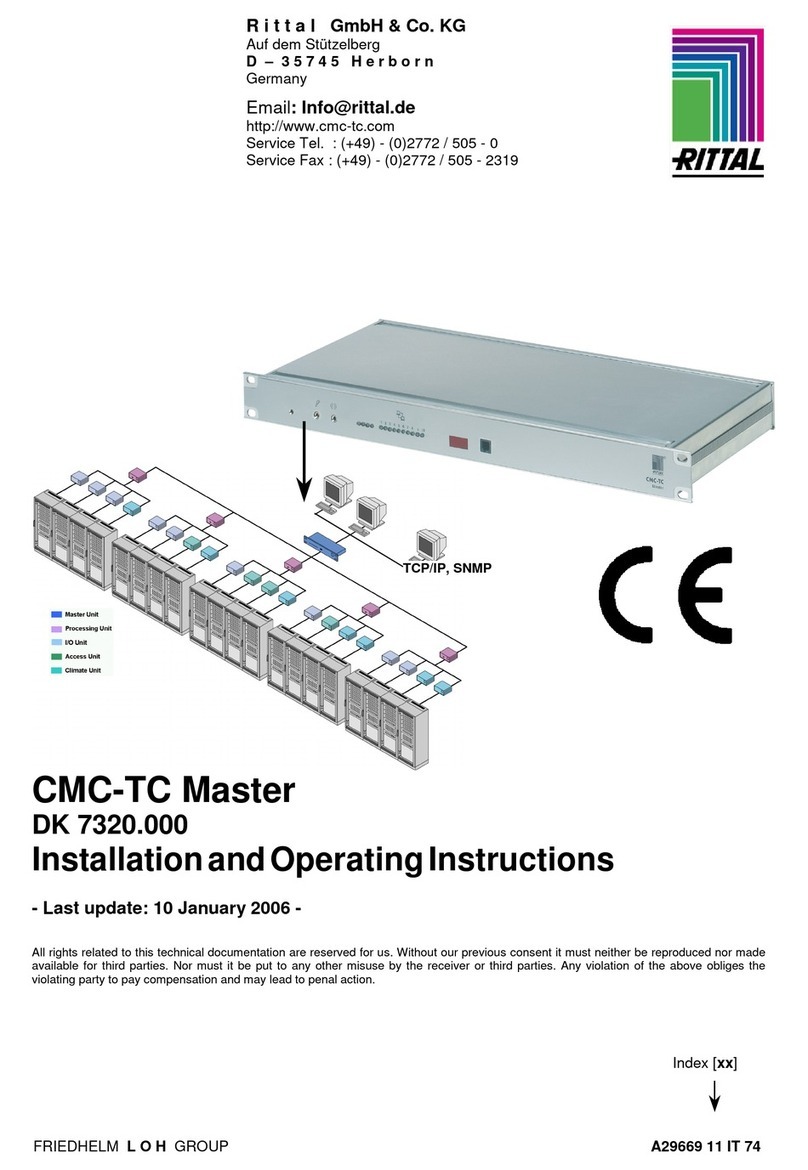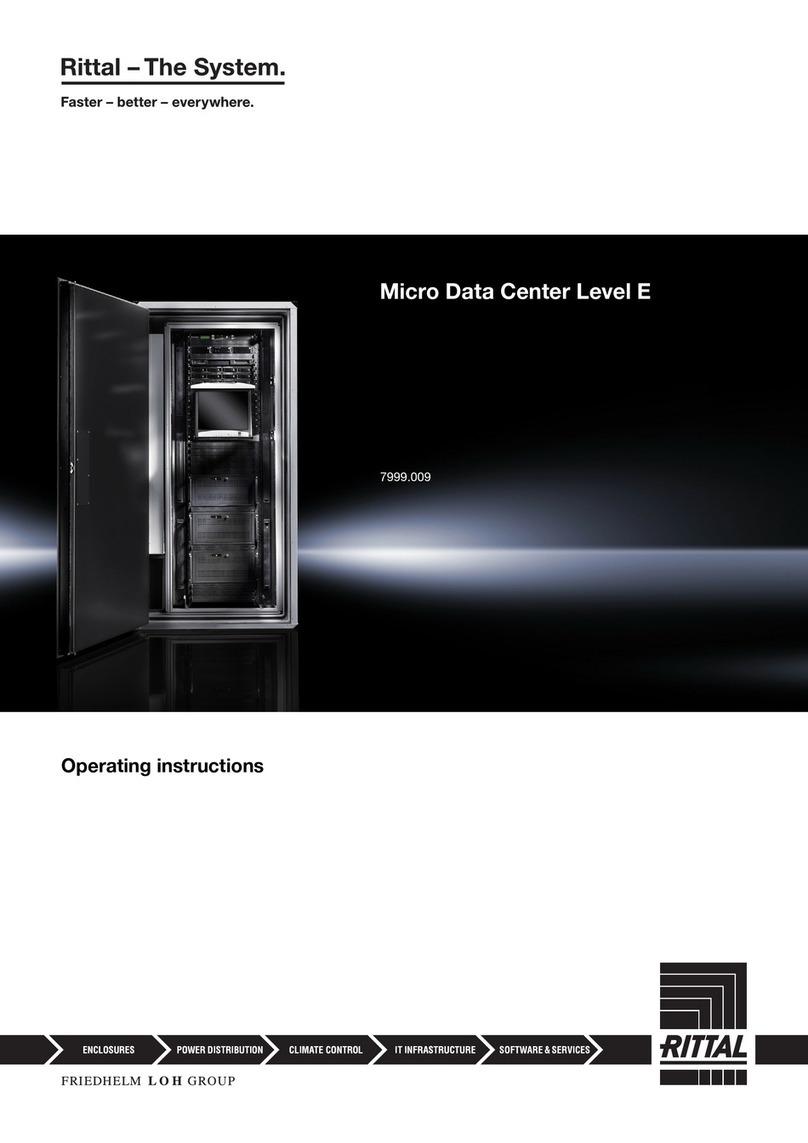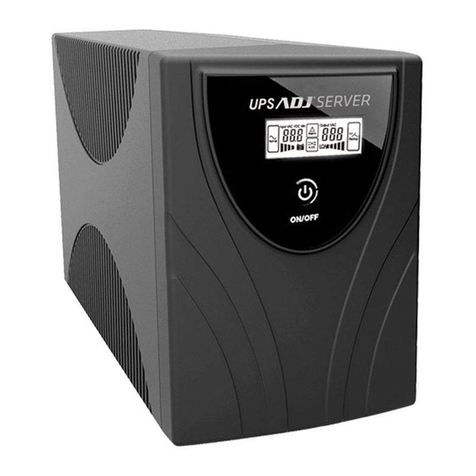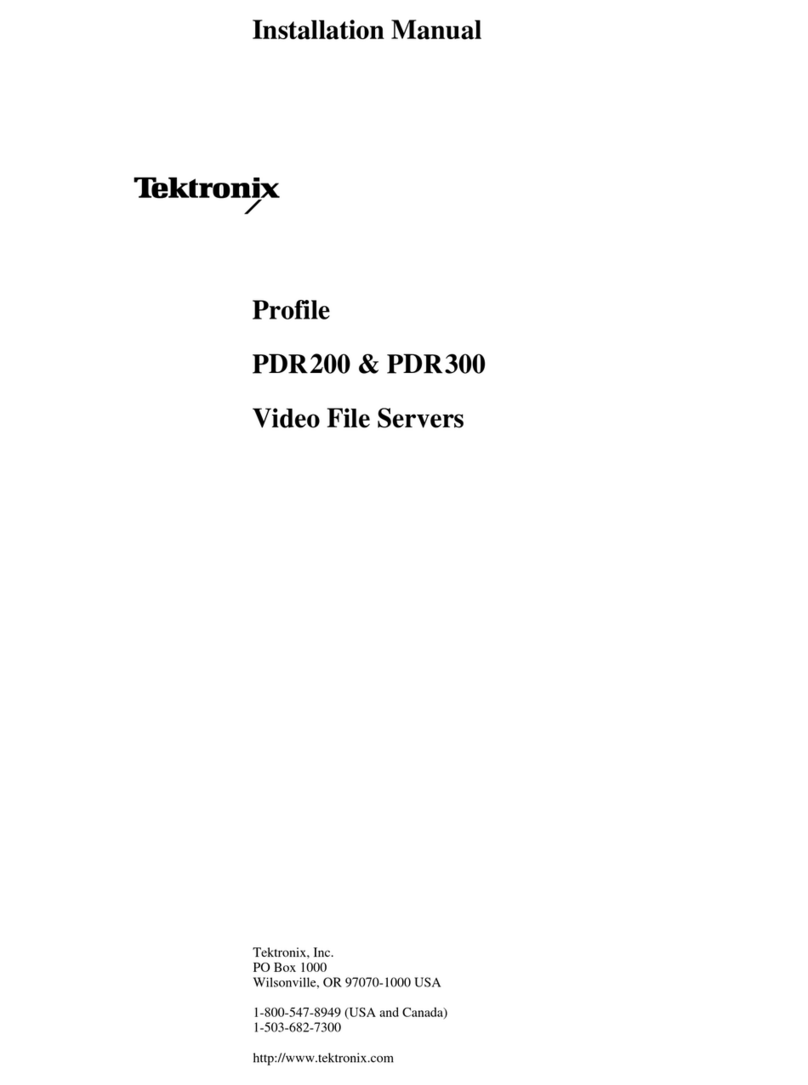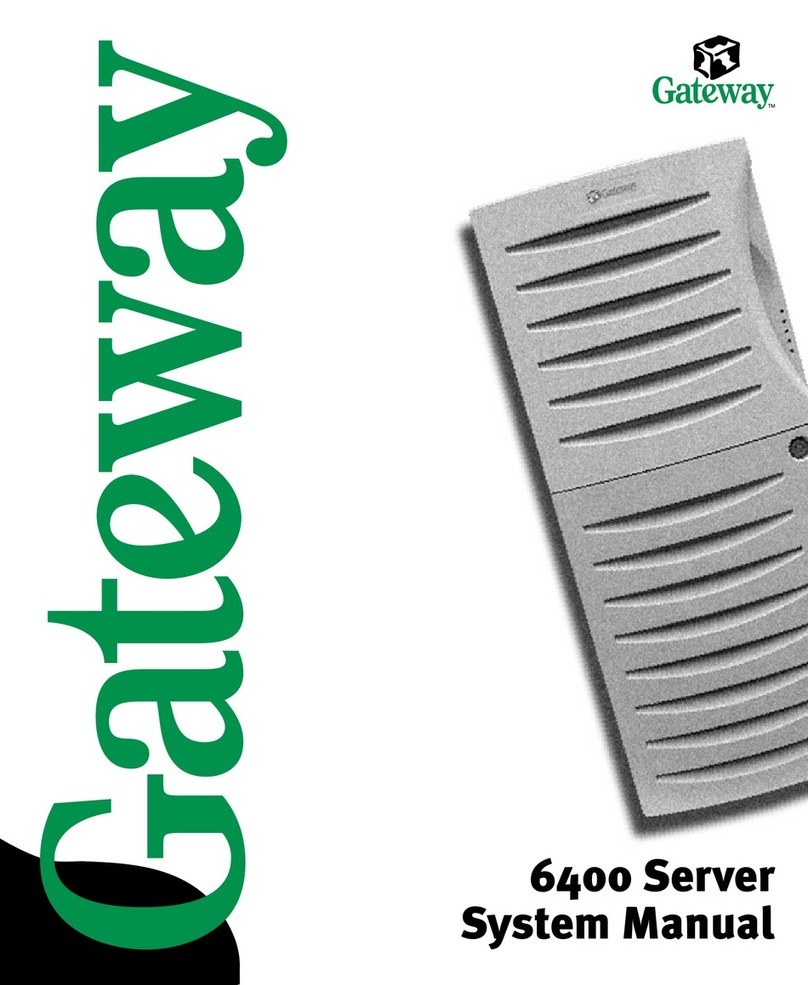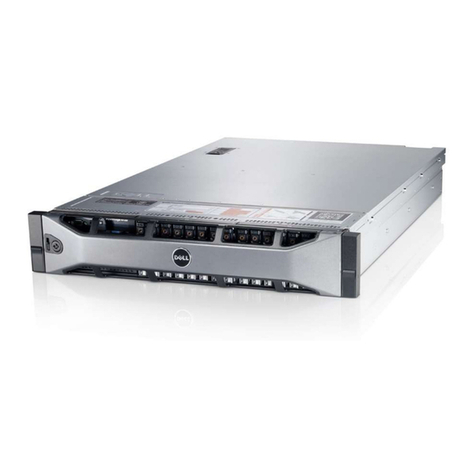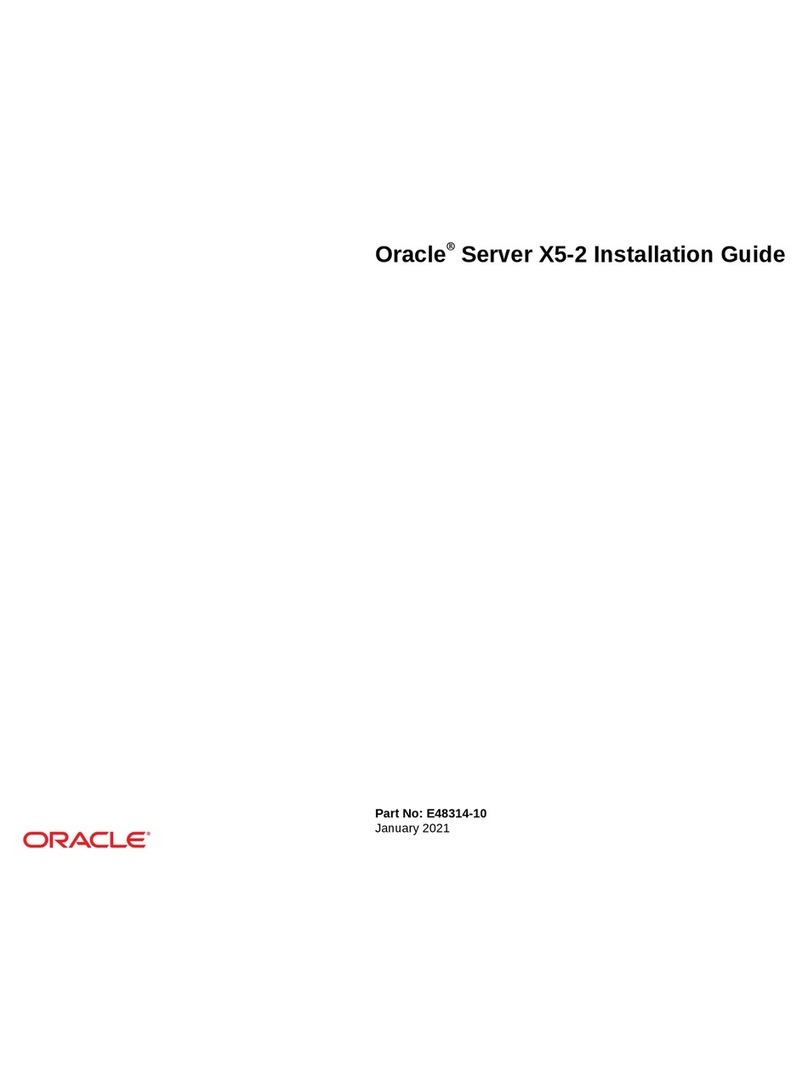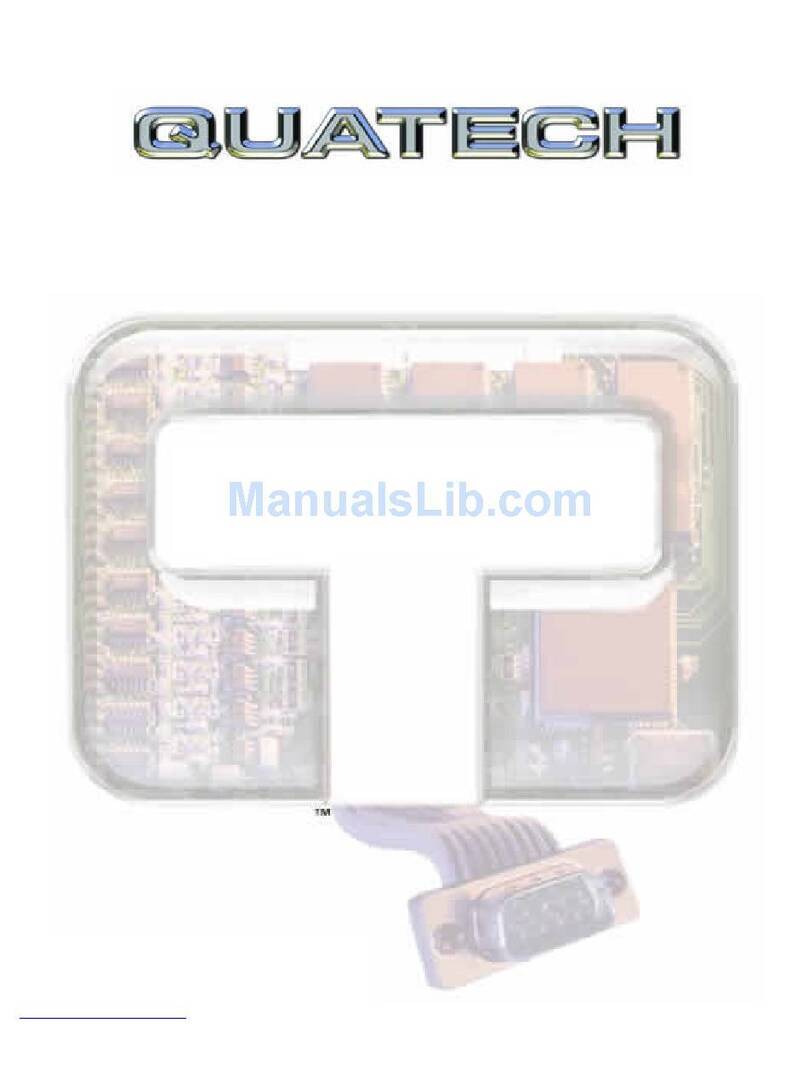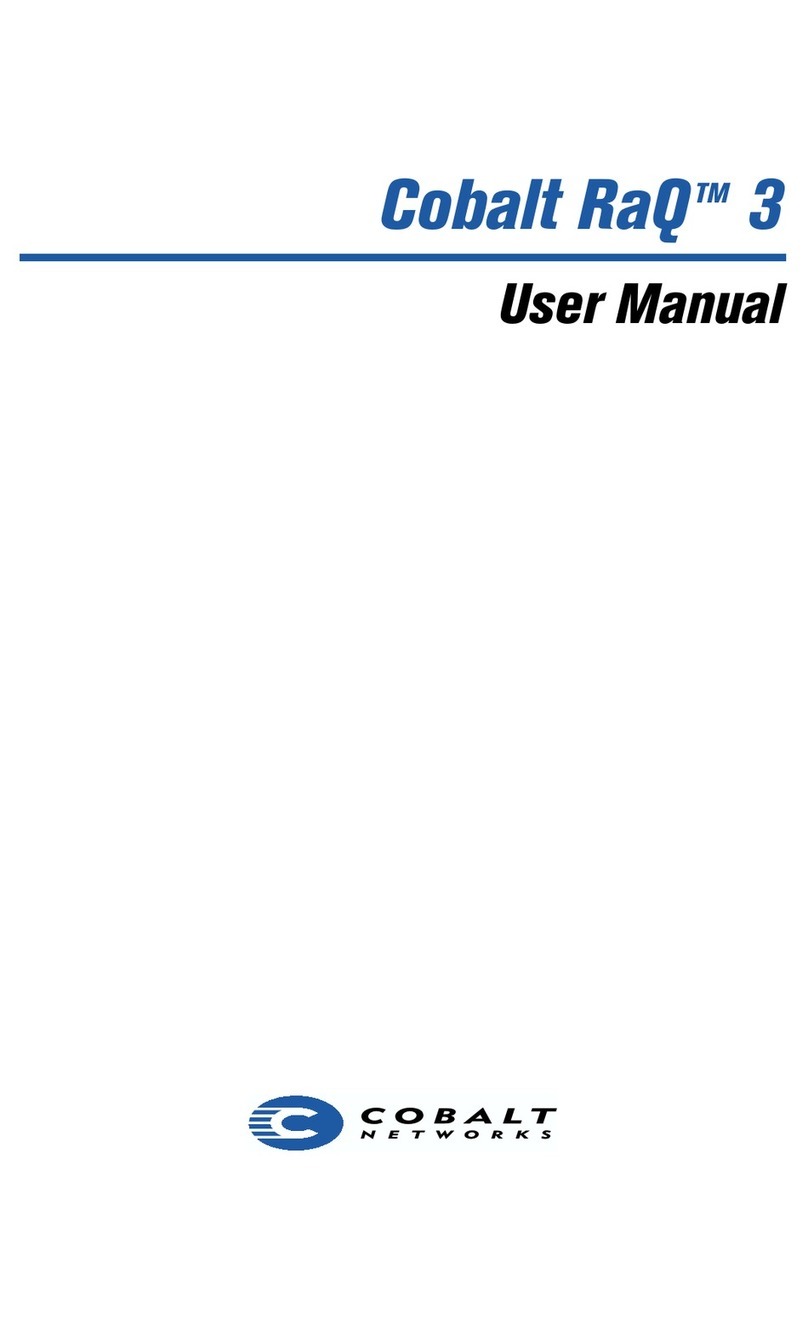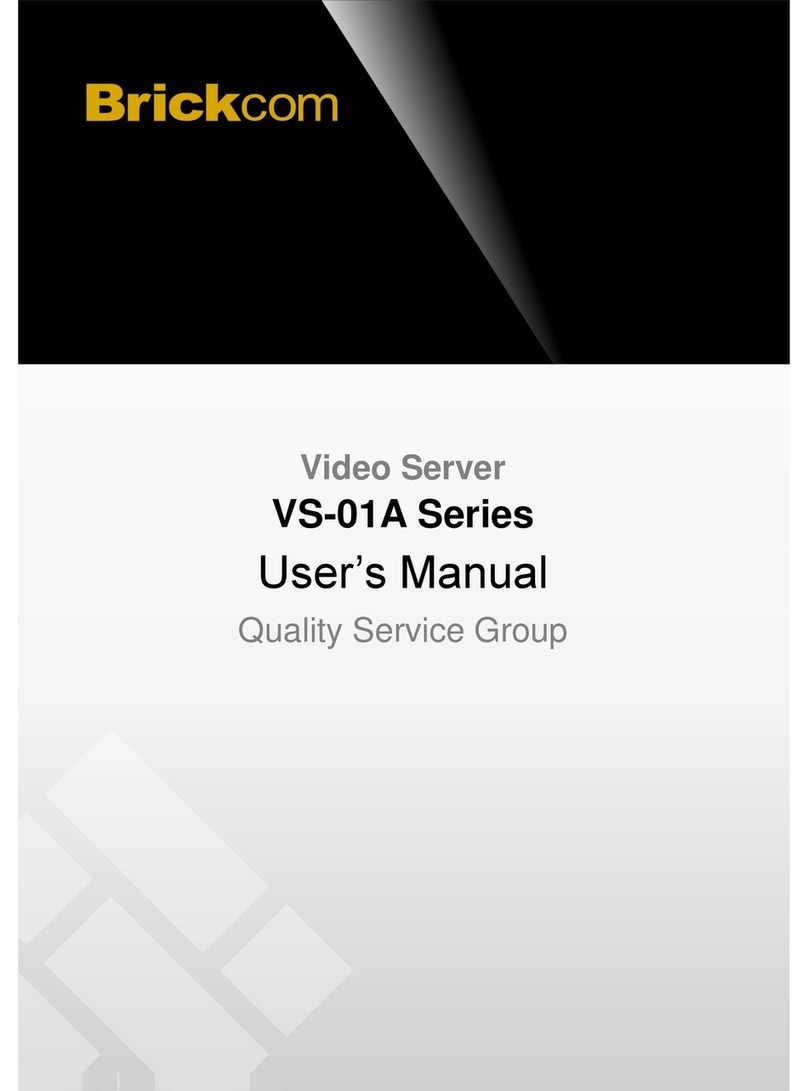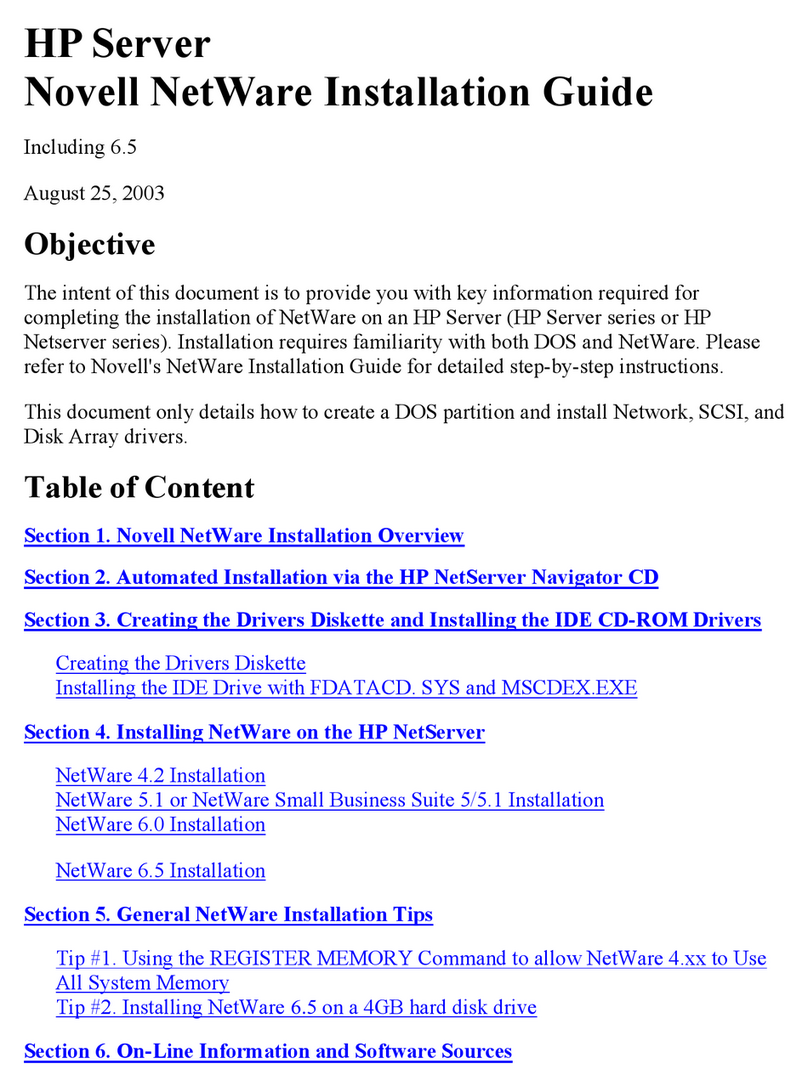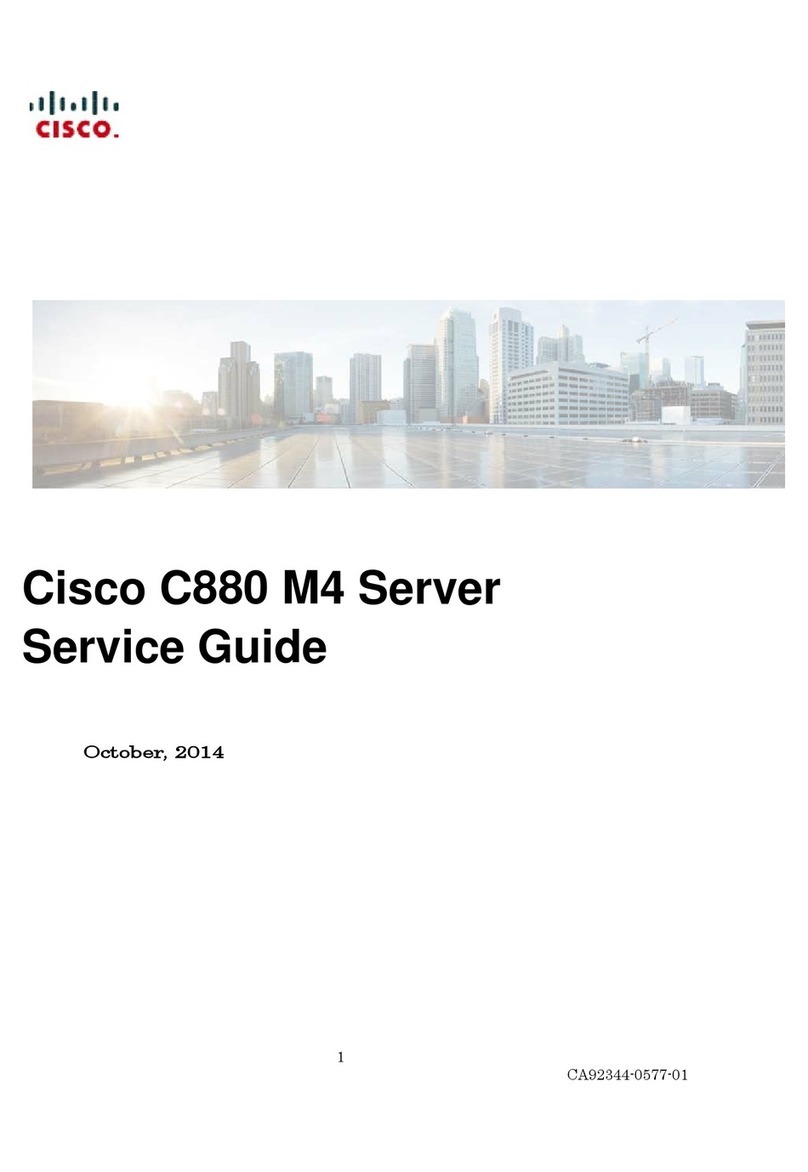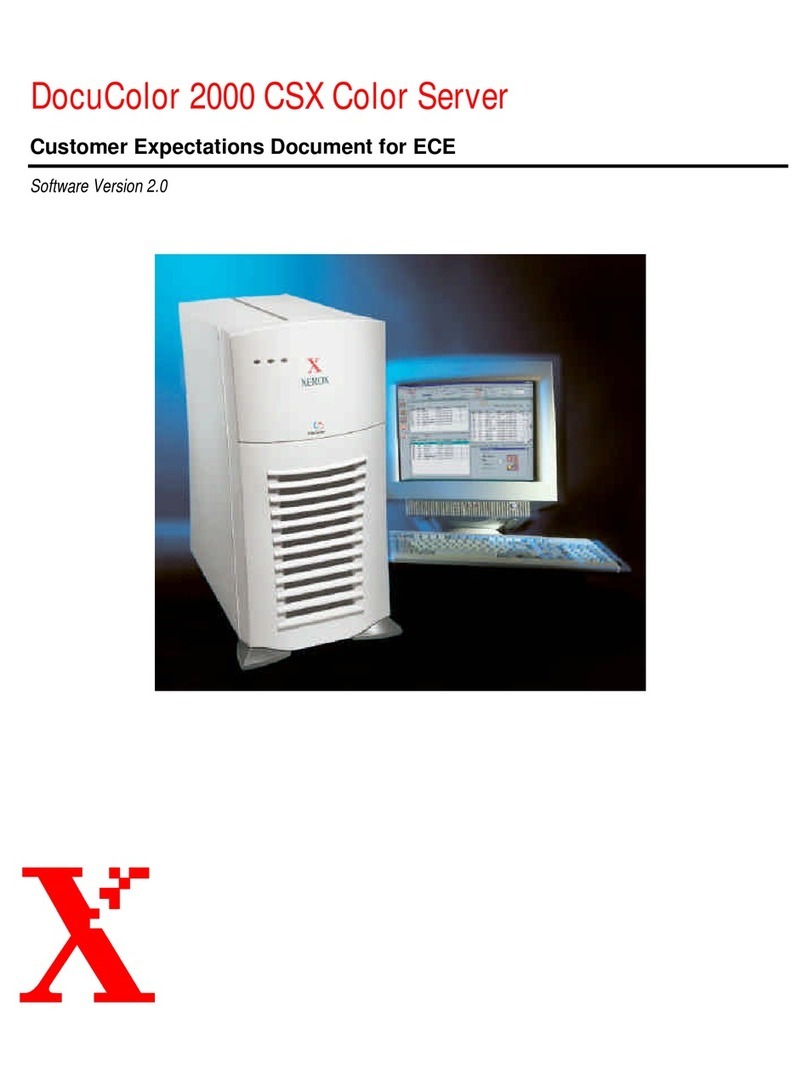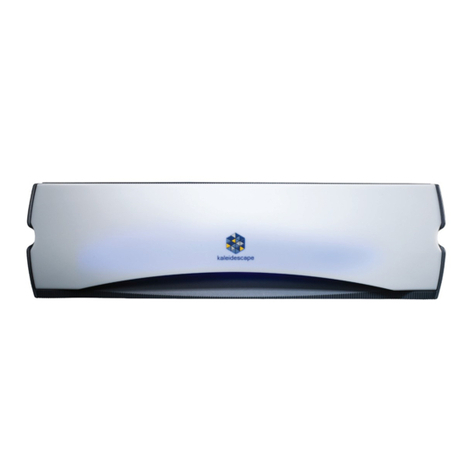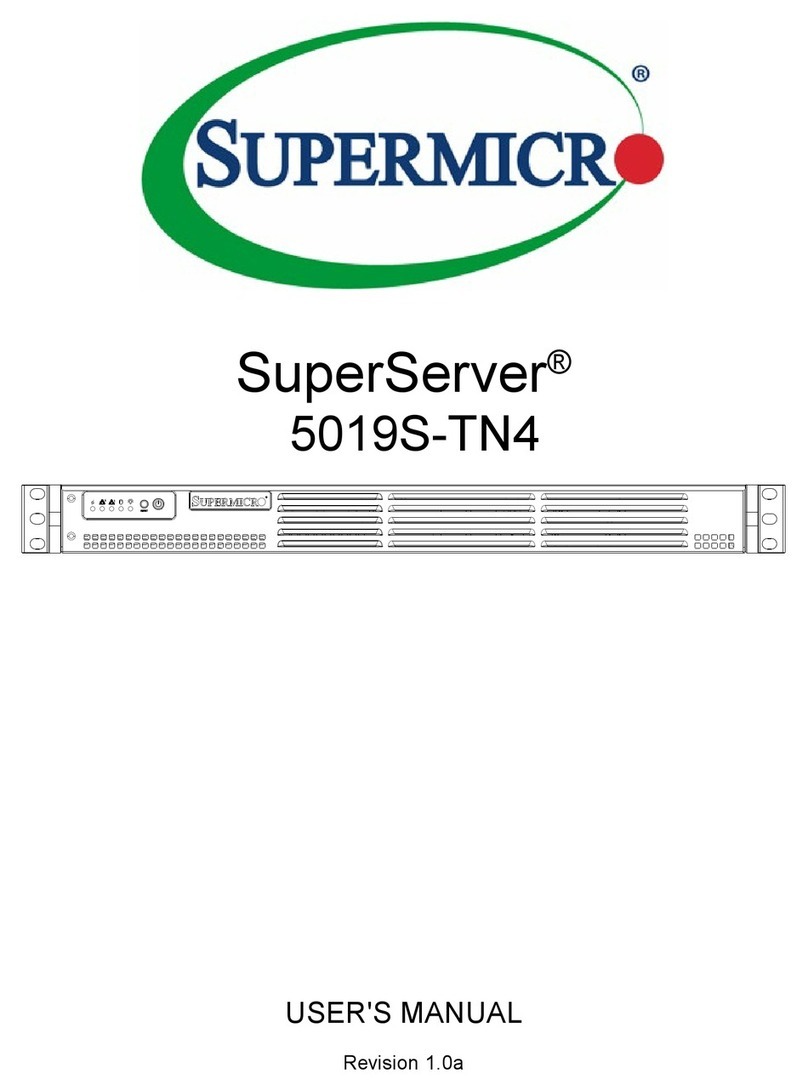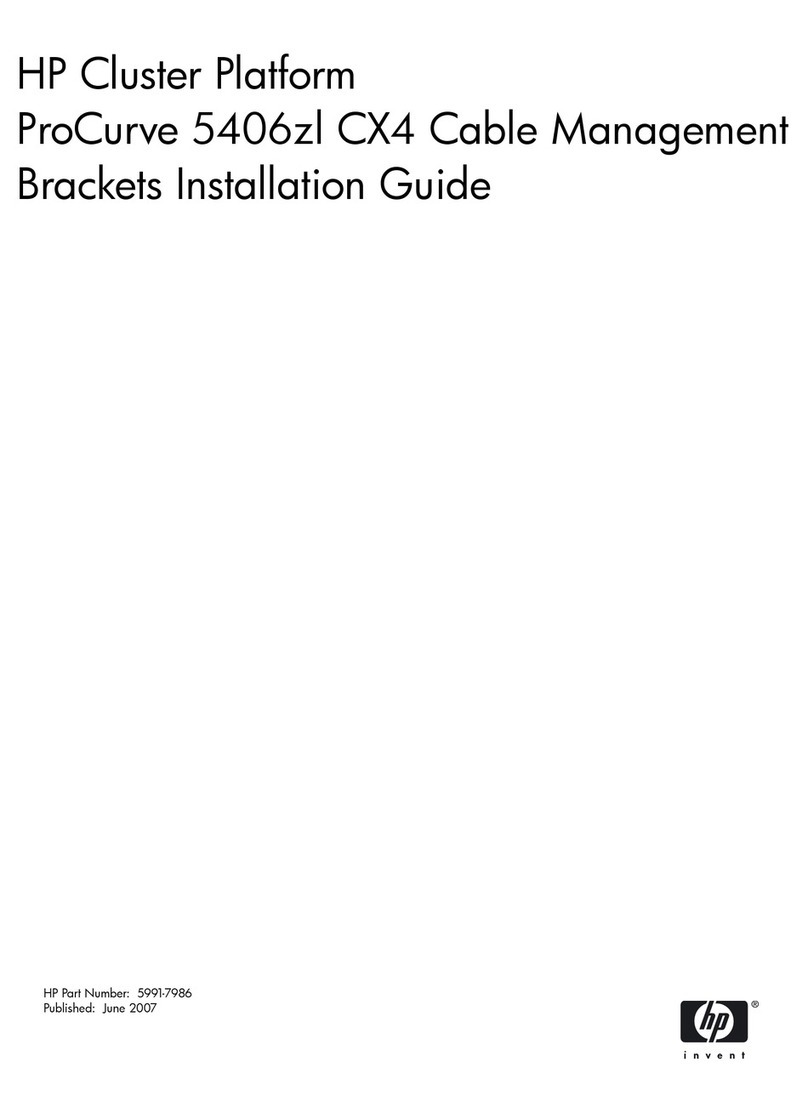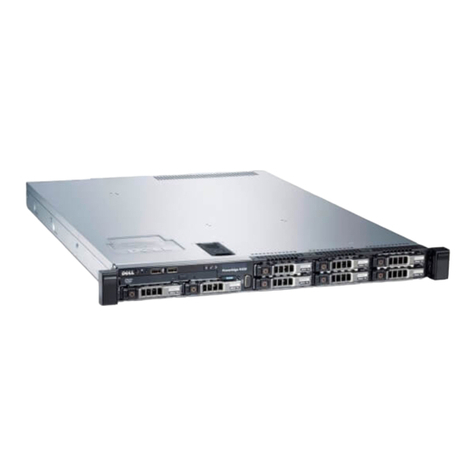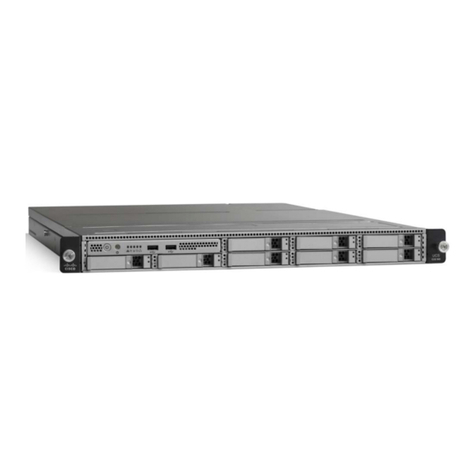Rittal TS 47U User manual

Installationsanleitung
Installation Guide
Schrank
Cabinet
PSB Rack 47U: 09 114 652


3
EN
Installationsanleitung / Installation guide
09114652
DE
Technische Daten
• Typ: Rittal TS 47U
• Abmessungen (BxHxT): 600 x ca. 2350 x 1000 mm
• Ausführung: mit Türen, auf Rollen
• AC-Anschluß: L1+L2+L3+N+PE
• AC-Versorgung: 380 V / 400 V / 480 V (L-L)
• AC-Strom: max. 167 A
• Gewicht: ca. 440 kg (voll bestückt)
• DC-Bus 1: 750 V / 60 A / 15 kW
• DC-Bus 2: 750 V / 120 A / 30 kW
• DC-Bus 3: 750 V / 180 A / 45 kW
Standardkonguration
• Rollen (4 Stück, davon 2 dreh- und feststellbar)
• Bestückbar mit bis zu 9 Modellen von
» PSB 9750-20 oder
» PSB 9750-40 oder
» PSB 9750-60
• Not-Aus-Kreis mit
» einem Schütz für alle Geräte
» Not-Aus-Schalter (Pilz), vertikal mittig auf Vordertür
» Anschluß für externe Kontakte
• 6x 230 V-Steckdosen mit insgesamt max. 16 A
Vorbereitung zur Installation
Wichtige Hinweise
• Verändern Sie nicht die Netzeingangs-Verdrahtung
bezüglich Leitungslänge, Absicherung und Quer-
schnitt!
• Der Netzanschluß muß extern abgesichert werden!
Aufstellung
Der Schrank wird auf Rollen geliefert, von denen die zwei
vorderen xiert werden können und sollen. Nach jeder
Ortsveränderung sind diese wieder festzustellen.
Wichtige Hinweise
• Der Schrank darf nur auf horizontalen Flächen
aufgestellt und betrieben werden.
• Der Schrank muß gegen Wegrollen gesichert sein,
neben der Fixierung der vorderen Rollen notfalls
durch weitere Maßnahmen
Der Schrank hat ein beträchtliches Gewicht. Stellen Sie
stets sicher, daß der Aufstellungsort und der Transport-
weg das Gewicht des Schrankes plus mehrerer Personen
mühelos tragen können.
Technical specications
• Type: Rittal TS 47U
• Dimensions (WxHxD): 600 x approx. 2350 x 1000 mm
• Model: with rear and front doors, on casters
• AC connection: L1+L2+L3+N+PE
• AC voltage: 380 V / 400 V / 480 V (L-L)
• AC current: max. 167 A
• Weight: approx. 440 kg (fully equipped)
• DC bus 1: 750 V / 60 A / 15 kW
• DC bus 2: 750 V / 120 A / 30 kW
• DC bus 3: 750 V / 180 A / 45 kW
Default conguration
• Casters (4 pieces of which 2 can be rotated and locked)
• Equippable with up to 9 units of
» PSB 9750-20 or
» PSB 9750-40 or
» PSB 9750-60
• Emergency stop circuit with
» one contactors for all units
» stop switch (on vertical middle of front door)
» connector for external breaker contacts
• 6x 230 V output (Schuko type) with total max. of 16 A
Preparing the installation
Important notes
• Do not modify the internal wiring, especially not
regarding cross section and cable length!
• The AC supply has to be fused externally!
Positioning
The cabinet is delivered with casters, of which two can
be locked. After every change of location they have to
be locked again.
Important notes
• The cabinet must only be positioned and operated
on horizontal ground
• The cabinet must be secured against rolling o,
either by locking the casters or removing them
The cabinet has a considerable weight. Always make sure
that the ground it is positioned on can carry the cabinet’s
weight plus that of a few persons without diculty.

4
EN
Installationsanleitung / Installation guide
09114652
DE
Be- und Entlüftung
Die Belüftung erfolgt über die Vorderseite (Zuluft) und
Rückseite (Abluft) des Schrankes. Die Türen sind luft-
durchlässig. Hinter dem Schrank muß daher mindestens
50 cm Platz gelassen werden.
Vorderseite und Rückseite dürfen nicht durch irgendwel-
che Gegenstände abgedeckt sein, die eine Luftzufuhr
verhindern könnten.
Installation der Geräte
Die Geräte werden getrennt vom Schrank geliefert und
sollte im Zuge der Installation des Schrankes mitinstalliert
werden.
Der Lieferumfang des Schrankes bzw. der Geräte enthält
alle Montagematerialen, die sich jedoch auf die Befesti-
gung der Geräte im Schrank, sowie den DC-Bus und
dessen Abdeckung beschränken. Bitte prüfen Sie nach
Erhalt der Lieferung den Lieferumfang des Schrankes
auf folgende Teile:
• 6x Sechskantbolzen mit Gewindestift M3x45
• 3x DC-Abdeckung (Plexiglas)
• 12x Kupferschiene (20x5x153 mm), davon 6x rot („+“)
und 6x blau („-“) lackiert
• 6x Rändelmutter M3
• 36x Schraube M5, vernickelt, mit U-Scheibe
• 6x Netzwerkkabel 50 cm für Master-Slave
• 8x Netzwerkkable 50 cm für Ethernet-Kette
• 3x Share-Bus-Kabel, zweipolig, mit 3 Steckern
Zwecks besserer Zugänglichkeit sollten die Geräte vor
der Installation des Schrankes und dessen AC-Anschluß
eingebaut werden. Folgende Schritte:
1. Geräte im Schrank plazieren
Schieben Sie die Geräte nacheinander in die vorgese-
henen Positionen (siehe auch Layout-Zeichnung weiter
hinten in diesem Dokument).
Die Frontplatte muß auf den vertikalen Lochstreifen im
Schrank auiegen. Befestigen Sie die Geräte an der
Front mittels der Langlochbohrungen links und rechts
von den Grien und den vernickelten M5-Schrauben, je
4 Stück pro Gerät.
2. Kupferschienen montieren
Es ist vorgesehen, jeweils drei Geräte an deren DC-
Ausgängen zu verbinden. Dazu werden jeweils 2 rote und
2 blau lackierte Kupferschienen benötigt und mittels der
M8-Schraubensets seitlich (mal außen, mal innen, siehe
Bild auf der nächsten Seite) an den DC-Anschlüssen der
Geräte befestigt. Die Schraubensets benden sich an den
Geräten. Blau ist für den Minuspol vorgesehen, welcher
sich auf der linke Seite des DC-Anschlusses bendet,
von der Rückseite des Schrankes aus gesehen.
Es wird empfohlen, pro Gruppe erst alle 6 Schraubensets
durch die Bohrungen zu führen und die Muttern locker
draufzuschrauben, bevor alle fest angezogen werden.
Air cooling
Operating the cabinet requires unobstructed air ventila-
tion from the front to the back. The installed doors have
a mesh which allows for sucient air circulation. Behind
the cabinet it requires to have at least 50 cm of space
for exhausting air.
Front and back door must not be obstructed in any way.
Device installation
The devices are delivered separate from the cabinet and
should be installed along with the cabinet.
The scope of delivery of the cabinet includes all material
for installation of the devices, the DC bus and the DC
cover.
After unpacking the cabinet verify the scope of delivery
for following content:
• 6x hexagon bolt with threaded bolt M3x45
• 3x DC cover (acrylic glass)
• 12x DC bus bar (copper, 20x5x153 mm), 6x painted in
red (“+”) and 6x blue (“-”)
• 6x knurled nut M3
• 36x screw M5, nickel plated, with washer
• 6x network cable 50 cm for master-slave
• 8x network cable 50 cm for Ethernet chain
• 3x Share bus cable, two wire, with 3 plugs
Due to better accessibility, it is recommended to install
the devices before connecting the cabinet to AC supply.
1. Placing the devices in the cabinet
Insert the units from top to bottom into the dedicated
positions (also see front view drawing below).
The front plate of every unit must rest on the vertical
hole-punched mount strip. Fix the units with the long
hole drillings next to the grips, using the nickel plated M5
screws (4x per unit).
2. Mounting the DC bus bars
It is intended to form three groups of three devices each,
using 2 red and 2 blue painted copper bars for each group.
They have to be attached on the side of the DC terminal,
(outside or inside, see gure on next page).
The M8 screw sets are attached to the devices. The blue
bars are for the negative pole, which is on the left side
of the DC terminal, when seen from behind the cabinet.
It’s recommended to rst put all 6 screw set (screw,
washers, lock washer, nut) through the holes and loosely
screw on the nut, then tighten all nuts rmly.

5
EN
Installationsanleitung / Installation guide
09114652
DE
3. DC-Kabel anschließen
In dem Schrank sind bis zu neun Geräte
aus der Serie PSB 9000 installiert. Die
Geräte sind bidirektional. Das bedeutet,
der DC-Anschluß ist gleichzeitig ein
Eingang für externe Spannungsquellen
(Senke-Betrieb) und Ausgang für exter-
ne Lasten (Quelle-Betrieb). Besonders
wenn externen Spannungsquellen an-
geschlossen wurden, sind besondere
Vorsichtsmaßnahmen geboten, da deren
Spannung noch anliegen und am Schrank
arbeitenden Personen gefährlich werden
kann, selbst wenn der Schrank ansonsten
komplett ausgeschaltet und vom Netz
getrennt worden ist.
Die Leitungen zu externen Lasten oder
Quellen sind nicht im Lieferumfang des
Schrankes oder der Geräte enthalten und
müssen vom Anwender der Anwendung
und den Anforderungen gängiger Normen
entsprechend selbst gefertigt werden.
Die Kabel müssen dabei an dem Ende,
das am DC-Bus der jeweiligen Gruppe
angebracht wird, immer mit M8 Ringka-
belschuhen versehen sein. Diese können
an irgendeinem der drei Anschlußpunkte
(Schraubensets) mit angeschraubt wer-
den. Wird nur ein Kabel pro Pol verwen-
det, was von der Gesamtstromstärke der Master-Slave-
Gruppe abhängig ist, wird empfohlen, das Kabel mittig
anzubringen.
Achtung!
Externe DC-Quellen immer polrichtig anschließen!
Die Geräte haben keinen Schutz gegen Verpolung und
können auch im ausgeschalteten Zustand beschädigt
werden.
4. DC-Abdeckung montieren
Die mitgelieferten Sechskantbolzen dienen zur Befesti-
gung der DC-Abdeckungen (je eine pro Gerätegruppe),
die wiederum als Berührungsschutz dient. Am dem obe-
ren und unteren Gerät der Gruppe, jeweils oberhalb des
DC-Anschlusses, ist eine M3-Gewindebohrung (siehe
das Bild oben, roter Kreis). Dort sind die M3x45 Sechs-
kantbolzen einzuschrauben. Auf diesen wird dann die
DC-Abdeckung mit einer Rändelmutter befestigt.
5. AC-Anschluß der Geräte
Der AC-Anschluß ist in Form eines Steckers für alle
Geräte im Schrank bereits vorhanden. Er muß lediglich
gesteckt werden. Danach wird der am AC-Filter montierte
Winkel xiert. Dieser soll den AC-Stecker gegen Heraus-
rutschen sichern. Das Netzkabel kann dann noch am
Winkel mittels einen Kabelbinders xiert werden. Siehe
auch die Zeichnung von der Rückansicht.
3. Connecting the DC cables
There are up to nine devices from series
PSB 9000 installed in the cabinet. These
devices are bidirectional. It means, the
DC bus is an input for external sourc-
es (sink operation) and and output for
external loads (source operation) at the
same time. Especially when connecting
external sources to the cabinet, higher
safety measures have to be considered
in order to protect persons working on the
DC bus from harm. Even if the cabinet is
completely switched o and cut from AC
supply, there can be dangerous voltage
present from outside.
The cables to connect to external loads
or external sources are not included in
the delivery and must be manufactured
according to the requirements of the
application, local standards and safety
provisions.
It is required to crimp M8 ring lugs onto
the cable ends which are going to be
mounted on the DC bus. These cable
ends are then screwed to any of the
three connection points using the screw
sets. If only one cable per pole is used,
which depends on the total current of the
master-slave group, it’s recommended to
connect it in the vertical middle.
Attention!
Always connect external DC sources with correct
polarity!
The devices do not have protection against false polarity
and can even be damaged in switched-o state.
4. Mounting the DC cover
The included hex bolts serve to mount the acrylic glass
DC covers (one for each group of devices), which serve
as a protection against touching the bus bars with their
dangerous voltage level. The units have a threaded hole
above the DC terminal (see gure above, red circle) where
the two hex bolts of 45 mm length are screwed to at the
upper and lower unit. After this the cover is placed onto
the hex bolts’ ends and xed with the knurled nuts.
5. Connecting AC supply to the devices
The AC input of the devices is simply connected with the
plugs installed in the cabinet. After this, the xture on the
AC lter box can be tied again, also xing the AC cable
with a cable strap.
Also see the rear view drawing of the cabinet below.

6
EN
Installationsanleitung / Installation guide
09114652
DE
6. Master-Slave-Bus verbinden
Der Master-Slave-Bus wird innerhalb einer Gruppe von
Geräten mittels zwei der mitgelieferten Netzwerkkabel
von Gerät zu Gerät verbunden. Siehe dazu auch die
Zeichnung von der Rückansicht weiter unten.
Weitere Informationen zum Master-Slave-Bus, dessen
Einstellungen und Busabschluß, sowie den Betrieb sind
im Handbuch zu den Geräten auf dem mitgelieferten
USB-Stick zu nden.
7. Share-Bus verbinden
Der Share-Bus wird für den Parallelbetrieb der Geräte
innerhalb der Gruppen genauso benötigt wie der Master-
Slave-Bus. Das benötigte Kabel wird mitgeliefert, ist
fertig konguriert und einsteckbereit. Es hat drei Stecker
für die drei Geräte jeder Gruppe und wird einfach in die
zweipoligen Buchsen namens „Share“ auf der Rückseite
der Geräte gesteckt. Siehe auch die Zeichnung von der
Rückansicht des Schrankes weiter unten.
Den Schrank anschließen
AC-Versorgung
Für den AC-Anschluß an die Hauptversorgung ist ein
Anschlußklemmbock an der Rückseite des Schrankes
(unten links) zugänglich, der mit L1, L2, L3, N und PE
beschriftet ist.
Hinweis
Der N- und der PE-Leiter sind unbedingt erforderlich
und müssen angeschlossen sein!
Die AC-Versorgung der PSB-Geräte ist mit je einem
32 A-Automaten abgesichert. Diese Automaten sind auf
der Vorderseite des Schrankes zugänglich. Die Hilfsver-
sorgung des Not-Aus-Kreises ist mit einem Doppel-16 A-
Automaten abgesichert, die 6 Steckdosen alle zusammen
mit einem 16 A-Automaten.
Die externe Verkabelung und Absicherung der AC-Ver-
sorgung muß gängigen Vorschriften und Anforderungen
entsprechen.
Anschlußklemme:
• Empfohlener Kabelquerschnitt: 70 mm²
• Empfohlene externe Absicherung: 180 A
• Anzugsdrehmoment: 15 - 20 Nm
• Abisolierungslänge: 33 mm
Kontakt für externen Not-Aus
Der Schrank bietet einen internen Not-Aus-Kreis mit
einem Öner-Kontakt (Not-Aus-Pilz, auf der Vordertür
montiert). Dieser kann durch einen oder mehrere exter-
ne Kontakte (24 V Schaltspannung) erweitert werden.
Dazu ist auf der Rückseite ein zweipoliger Schrauban-
schluß (grau) mit einer Brücke (orangefarbenes Kabel)
zugänglich.
6. Connecting the master-slave bus
The master-slave bus is connected from device to de-
vice within the group of devices, using 2 of the supplied
network cables. Also see the rear view drawing below.
Further information about the master-slave bus, its
settings and bus termination, as well as master-slave
operation can be found in the user manual of the devices,
which is included on the supplied USB stick.
7. Connecting the share bus
The Share bus is required for parallel operation as well.
The required cable is included in the delivery, precon-
gured and ready to be plugged. It has three plugs for
three units and is plugged to the two-pin connectors on
the rear side labelled as “Share”. Also see the rear view
drawing of the cabinet below.
Connecting the cabinet
AC supply
The AC connection is done using the terminal block which
is accessible on the rear side of the cabinet in the bottom
left side and which is labelled with L1, L2, L3, N and PE.
Note
The conductors N and PE are absolutely required!
The AC supply for the PSB units is fused with a 32 A
circuit breaker each. These CBs are accessible on the
front side of the cabinet. The internal auxiliary supply of
the emergency stop circuit is fused with a double 16 A
CB, the 6 extra outlets are all fused with one 16 A CB.
The AC wiring and external fusing has to meet local
specications and regulations.
AC screw terminal:
• Recommended cable cross section: 70 mm²
• Recommended external fusing: 180 A
• Required torque: 15 - 20 Nm
• Stripping length: 33 mm
Contact for external emergency stop
The cabinet features an emergency stop circuit with one
manual breaker contact (switch, mounted on the front
door). It can be extended by one or several external
contacts (24 V line). Accessible from the rear side, on the
left hand side of the cabinet, there is a two-pole screw
terminal (grey) which is bridged by an orange cable.

7
EN
Installationsanleitung / Installation guide
09114652
DE
Für die Einbindung des/der externen Kontakte muß die
Brücke entfernt werden. Es sind Kontakte nach Öner-
prinzip erforderlich.
Netzwerkanschluß
Die Geräte werden mit Ethernet-Schnittstellenmodulen
geliefert, die entweder bereits in den Geräten installiert
sind oder separat mitgeliefert werden. Falls diese nicht
installiert sind, müssen sie zunächst gemäß der Einbau-
anleitung im Handbuch der Geräte installiert werden.
Danach können die Module entweder alle einzeln zu
einem Netzwerk-Switch oder von Gerät zu Gerät mittels
der enthaltenen Netzwerkkabel durchverbunden werden,
so daß an beiden Enden der Kette ein freier Port übrig-
bleibt. Einer von diesen beiden oder auch beide können
dann mit einem Netzwerk-Switch verbunden werden.
Würde man beide verbinden, entstünde ein Ring, der
davor schützt, daß bei Ausfall eines Gerätes die in der
Kette nachfolgenden Geräte per Netzwerk nicht mehr
erreichbar wären.
This bridge has to be removed to implement the external
contacts. They are required to be breakers.
Network connection
The devices are delivered with an Ethernet interface
module each, which is either already installed in the de-
vice or delivered separately. If not installed, they have to
be installed rst according to the instructions in the user
manual of the devices.
After this, the devices can be connected to a network
switch, either all of them separately or they are connected
to each other, building a chain. Doing so leaves open ports
at both ends of which one or both can be connected to a
network switch. Connecting both ends would build a ring
and help to protect losing contact to devices in situations
when one unit fails and interrupting the chain.

8
EN
Installationsanleitung / Installation guide
09114652
DE
Betrieb
Achtung! Lebensgefahr!
• Beim Betrieb elektrischer Geräte
stehen zwangsweise bestimmte Teile
unter teils gefährlicher Spannung.
Daher sind alle spannungsführenden
Teile abzudecken!
• Alle Arbeiten an den Anschlussklem-
men müssen im spannungslosen Zu-
stand des Gerätes erfolgen (Eingang
nicht verbunden mit Spannungsquel-
len) und dürfen nur von Personen
durchgeführt werden, die mit den
Gefahren des elektrischen Stroms
vertraut sind oder unterrichtet wurden!
Unsachgemäßer Umgang mit diesen
Geräten kann zu tödlichen Verletzun-
gen, sowie erheblichen Sachschäden
führen.
• Berühren Sie die Kontakte am Netz-
kabel oder der Netzanschlußbuchse
nie direkt nach dem Entfernen des
Kabels aus der Steckdose oder dem
Hauptanschluß, da die Gefahr eines
Stromschlags besteht!
• Da einige Geräte im Schrank Senken
sind und einen Eingang haben, kann
an diesem selbst bei Trennung der
AC-Versorgung noch berührungsge-
fährliche Spannung von einer externen
Quelle anliegen!
Operation
Mortal danger - Hazardous
voltage
• Electrical equipment operation means
that some parts can be under danger-
ous voltage. Therefore all parts under
voltage must be covered!
• All work on connections must be car-
ried out under zero voltage (input not
connected to source) and may only be
performed by qualied and informed
persons. Improper actions can cause
fatal injury as well as serious material
damage.
• Never touch cables or connectors di-
rectly after disconnecting from mains
supply, as there is risk of electric shock
due to not yet fully discharged capac-
itors!
• Some of the devices in the cabinet are
sinks, which are supplied voltage from
external sources. Even in situations
where the cabinet is disconnected from
AC supply hazardous voltage could still
supplied to the DC bus by a source!

9
EN
Installationsanleitung / Installation guide
09114652
DE
• Das Gerät ist ausschließlich seiner Bestim-
mung gemäß zu verwenden!
• Das Gerät ist nur für den Betrieb innerhalb
der auf dem Typenschild angegebenen
Anschlußwerte und technischen Daten
zugelassen.
• Führen Sie keine mechanischen Teile,
insbesondere aus Metall, durch die Lüf-
tungsschlitze in das Gerät ein.
• Vermeiden Sie die Verwendung von Flüs-
sigkeiten aller Art in der Nähe des Gerätes,
diese könnten in das Gerät gelangen.
Schützen Sie das Gerät vor Nässe, Feuch-
tigkeit und Kondensation.
• Für Netzgeräte und Batterielader: Schlie-
ßen Sie Verbraucher, vor allem niederoh-
mige, nie bei eingeschaltetem Leistungs-
ausgang an, es können Funken und
dadurch Verbrennungen an den Händen,
sowie Beschädigungen am Gerät und am
Verbraucher entstehen!
• Für elektronische Lasten: Schließen Sie
Spannungsquellen nie bei eingeschaltetem
Leistungseingang an, es können Funken
und dadurch Verbrennungen an den Hän-
den, sowie hohe Spannungsspitzen und
Beschädigungen am Gerät und an der
Quelle entstehen!
• Um Schnittstellenkarten oder -module in
dem dafür vorgesehenen Einschub (Slot)
zu bestücken, müssen die einschlägigen
ESD –Vorschriften beachtet werden.
• Nur im ausgeschalteten Zustand darf eine
Schnittstellenkarte bzw. -modul aus dem
Einschub herausgenommen oder bestückt
werden. Eine Önung des Gerätes ist nicht
erforderlich.
• Keine externen Spannungsquellen mit um-
gekehrter Polarität am DC-Ausgang bzw.
DC-Eingang anschließen! Das Gerät wird
dadurch beschädigt.
• Für elektronische Lasten: keine Span-
nungsquelle am DC-Eingang anschließen,
die eine Spannung erzeugen kann, die
höher ist als 110% der Nenneingangs-
spannung der Last. Das Gerät ist gegen
Überspannungen nicht geschützt, diese
können das Gerät zerstören.
• Niemals Netzwerkkabel, die mit dem Ether-
net oder dessen Komponenten verbunden
sind, in die Master-Slave-Buchsen auf der
Rückseite stecken!
• The equipment must only be used as
intended
• The equipment is only approved for use
within the connection limits stated on the
product label.
• Do not insert any object, particularly metal-
lic, through the ventilator slots
• Avoid any use of liquids near the equip-
ment. Protect the device from wet, damp
and condensation.
• For power supplies and battery chargers:
do not connect users, particularly low re-
sistance, to devices under power; sparking
may occur which can cause burns as well
as damage to the equipment and to the
user.
• Do not connect DC power sources to
electronic load devices while the input is
switched on. Sparking may occur which
can cause burns as well as damage to the
equipment and to the source.
• ESD regulations must be applied when
plugging interface cards or modules into
the relative slot
• Interface cards or modules may only be
attached or removed after the device is
switched o. It is not necessary to open
the device.
• Do not connect external power sources with
reversed polarity to DC input or outputs!
The equipment will be damaged.
• Do not connect a power source to the DC
input which can generate a voltage more
than 110% of the nominal input voltage of
the load. The equipment is not protected
against over voltage and may be irrepara-
bly damaged.
• Never insert a network cable which is con-
nected to Ethernet or its components into
the master-slave socket on the back side
of the device!

10
EN
Installationsanleitung / Installation guide
09114652
DE
Verantwortung des Bedieners
Das Gerät bendet sich im gewerblichen Einsatz. Das
Personal unterliegt daher den gesetzlichen Pichten zur
Arbeitssicherheit. Neben den Warn- und Sicherheitshin-
weisen in dieser Anleitung müssen die für den Einsatz-
bereich gültigen Sicherheits-, Unfallverhütungs- und Um-
weltschutzvorschriften eingehalten werden. Insbesondere
gilt, daß die das Gerät bedienenden Personen:
• sich über die geltenden Arbeitsschutzbestimmungen
informieren.
• die zugewiesenen Zuständigkeiten für die Bedienung,
Wartung und Reinigung des Gerätes ordnungsgemäß
wahrnehmen.
• vor Arbeitsbeginn die Betriebsanleitung vollständig
gelesen und verstanden haben.
• die vorgeschriebenen und empfohlenen Schutzausrü-
stungen anwenden.
• Weiterhin ist jeder an dem Gerät Beschäftigte in seinem
Zuständigkeitsumfang dafür verantwortlich, daß das
Gerät stets in technisch einwandfreiem Zustand ist.
Pichten des Betreibers
Betreiber ist jede natürliche oder juristische Person, die
das Gerät nutzt oder Dritten zur Anwendung überläßt und
während der Nutzung für die Sicherheit des Benutzers,
des Personals oder Dritter verantwortlich ist.
Das Gerät wird im gewerblichen Bereich eingesetzt. Der
Betreiber des Gerätes unterliegt daher den gesetzlichen
Pichten zur Arbeitssicherheit. Neben den Warn- und
Sicherheitshinweisen in dieser Anleitung müssen die für
den Einsatzbereich des Gerätes gültigen Sicherheits-,
Unfallverhütungs- und Umweltschutzvorschriften einge-
halten werden. Insbesondere muß der Betreiber:
• sich über die geltenden Arbeitsschutzbestimmungen
informieren.
• durch eine Gefährdungsbeurteilung mögliche zusätz-
liche Gefahren ermitteln, die sich durch die speziellen
Anwendungsbedingungen am Einsatzort des Gerätes
ergeben.
• in Betriebsanweisungen die notwendigen Verhaltensan-
forderungen für den Betrieb des Gerätes am Einsatzort
umsetzen.
• während der gesamten Einsatzzeit des Gerätes re-
gelmäßig prüfen, ob die von ihm erstellten Betriebs-
anweisungen dem aktuellen Stand der Regelwerke
entsprechen.
• die Betriebsanweisungen, sofern erforderlich, an neue
Vorschriften, Standards und Einsatzbedingungen an-
passen.
• die Zuständigkeiten für die Installation, Bedienung,
Wartung und Reinigung des Gerätes eindeutig und
unmißverständlich regeln.
• dafür sorgen, daß alle Mitarbeiter, die an dem Gerät
beschäftigt sind, die Betriebsanleitung gelesen und ver-
standen haben. Darüber hinaus muss er das Personal
in regelmäßigen Abständen im Umgang mit dem Gerät
schulen und über die möglichen Gefahren informieren.
Responsibility of the user
The equipment is in industrial operation. Therefore the
operators are governed by the legal safety regulations.
Alongside the warning and safety notices in this manual
the relevant safety, accident prevention and environmen-
tal regulations must also be applied. In particular the
users of the equipment:
• must be informed of the relevant job safety require-
ments
• must work to the dened responsibilities for operation,
maintenance and cleaning of the equipment
• before starting work must have read and understood
the operating manual
• must use the designated and recommended safety
equipment.
• Furthermore, anyone working with the equipment is
responsible for ensuring that the device is at all times
technically t for use.
Responsibility of the operator
Operator is any natural or legal person who uses the
equipment or delegates the usage to a third party, and
is responsible during its usage for the safety of the user,
other personnel or third parties.
The equipment is in industrial operation. Therefore the
operators are governed by the legal safety regulations.
Alongside the warning and safety notices in this manual
the relevant safety, accident prevention and environmen-
tal regulations must also be applied. In particular the
operator has to
• be acquainted with the relevant job safety requirements
• identify other possible dangers arising from the spe-
cic usage conditions at the work station via a risk
assessment
• introduce the necessary steps in the operating proce-
dures for the local conditions
• regularly control that the operating procedures are
current
• update the operating procedures where necessary to
reect changes in regulation, standards or operating
conditions.
• dene clearly and unambiguously the responsibilities for
operation, maintenance and cleaning of the equipment.
• ensure that all employees who use the equipment
have read and understood the manual. Furthermore
the users are to be regularly schooled in working with
the equipment and the possible dangers.
• provide all personnel who work with the equipment with
the designated and recommended safety equipment
• install an external device (e .g. according to section 5.2
of IEC/EN 60204-1) which enables the cabinet to be
disconnect from any power source

11
EN
Installationsanleitung / Installation guide
09114652
DE
• dem mit Arbeiten an dem Gerät beauftragten Personal
die vorgeschriebenen und empfohlenen Schutzausrü-
stungen bereitstellen.
Weiterhin ist der Betreiber dafür verantwortlich, daß das
Gerät stets in einem technisch einwandfreien Zustand ist.
Anforderungen an das Bedienpersonal
Jegliche Tätigkeiten an Geräten dieser Art dürfen nur
Personen ausüben, die ihre Arbeit ordnungsgemäß und
zuverlässig ausführen können und den jeweils benannten
Anforderungen entsprechen.
• Personen, deren Reaktionsfähigkeit beeinußt ist, z.
B. durch Drogen, Alkohol oder Medikamente, dürfen
keine Arbeiten ausführen.
• Beim Personaleinsatz immer die am Einsatzort gel-
tenden alters- und berufsspezischen Vorschriften
beachten.
Verletzungsgefahr bei unzureichender
Qualikation!
Unsachgemäßes Arbeiten kann zu Perso-
nen- und Sachschäden führen. Jegliche
Tätigkeiten dürfen nur Personen ausführen,
welche die erforderliche Ausbildung, das
notwendige Wissen und die Erfahrung dafür
besitzen.
Als unterwiesenes Personal gelten Personen, die
vom Betreiber über die ihnen übertragenen Aufgaben
und möglichen Gefahren ausführlich und nachweislich
unterrichtet wurden.
Als Fachpersonal gilt, wer aufgrund seiner beruichen
Ausbildung, Kenntnisse und Erfahrungen sowie Kenntnis
der einschlägigen Bestimmungen in der Lage ist, die
übertragenen Arbeiten ordnungsgemäß auszuführen,
mögliche Gefahren selbständig zu erkennen und Perso-
nen- oder Sachschäden zu vermeiden.
Bedienung und Fernsteuerung der Geräte
Siehe separate Geräte-Handbücher auf dem beiliegen-
den USB-Stick.
Furthermore, the operator is responsible for ensuring that
the device is at all times technically t for use.
User requirements
Any activity with equipment of this type may only be per-
formed by persons who are able to work correctly and
reliably and satisfy the requirements of the job.
• Persons whose reaction capability is negatively inu-
enced by e.g. drugs, alcohol or medication may not
operate the equipment.
• Age or job related regulations valid at the operating site
must always be applied.
Danger for unqualied users
Improper operation can cause person or
object damage. Only persons who have the
necessary training, knowledge and experi-
ence may use the equipment.
“Delegated persons” are those who have been prop-
erly and demonstrably instructed in their tasks and the
attendant dangers.
“Qualied persons” are those who are able through
training, knowledge and experience as well as knowledge
of the specic details to carry out all the required tasks,
identify dangers and avoid personal and other risks.
Handling and remote control of the devices
See separate manuals on the included USB stick.

12
EN
Installationsanleitung / Installation guide
09114652
DE
Ansichten & Aufteilung Views & Layout
Rückansicht / Rear viewVorderansicht / Front view
1
0
POWERSU PPLY
PSB9 750-60 3U
0...750V/ 0...60A
0...15000 W
Cursor Position
USB
On Off
On / Off
On Off
On / Off
Cursor Position
0.00 V
0.00 A
0kW
48.00 V
1530.0 A
45.00 kW
UI
1
0
POWERSU PPLY
PSB9 750-60 3U
0...750V/ 0...60A
0...15000 W
Cursor Position
USB
On Off
On / Off
On Off
On / Off
Cursor Position
0.00 V
0.00 A
0kW
48.00 V
1530.0 A
45.00 kW
UI
1
0
POWERSU PPLY
PSB9 750-60 3U
0...750V/ 0...60A
0...15000 W
Cursor Position
USB
On Off
On / Off
On Off
On / Off
Cursor Position
0.00 V
0.00 A
0kW
48.00 V
1530.0 A
45.00 kW
UI
1
0
POWERSU PPLY
PSB9 750-60 3U
0...750V/ 0...60A
0...15000 W
Cursor Position
USB
On Off
On / Off
On Off
On / Off
Cursor Position
0.00 V
0.00 A
0kW
48.00 V
1530.0 A
45.00 kW
UI
1
0
POWERSU PPLY
PSB9 750-40 3U
0...750V/ 0...40A
0...10000 W
Cursor Position
USB
On Off
On / Off
On Off
On / Off
Cursor Position
0.00 V
0.00 A
0kW
48.00 V
1530.0 A
45.00 kW
UI
1
0
POWERSU PPLY
PSB9 750-40 3U
0...750V/ 0...40A
0...10000 W
Cursor Position
USB
On Off
On / Off
On Off
On / Off
Cursor Position
0.00 V
0.00 A
0kW
48.00 V
1530.0 A
45.00 kW
UI
1
0
POWERSU PPLY
PSB9 750-60 3U
0...750V/ 0...60A
0...15000 W
Cursor Position
USB
On Off
On / Off
On Off
On / Off
Cursor Position
0.00 V
0.00 A
0kW
48.00 V
1530.0 A
45.00 kW
UI
1
0
POWERSU PPLY
PSB9 750-60 3U
0...750V/ 0...60A
0...15000 W
Cursor Position
USB
On Off
On / Off
On Off
On / Off
Cursor Position
0.00 V
0.00 A
0kW
48.00 V
1530.0 A
45.00 kW
UI
1
0
POWERSU PPLY
PSB9 750-60 3U
0...750V/ 0...60A
0...15000 W
Cursor Position
USB
On Off
On / Off
On Off
On / Off
Cursor Position
0.00 V
0.00 A
0kW
48.00 V
1530.0 A
45.00 kW
UI
1
0
POWERSU PPLY
PSB9 750-60 3U
0...750V/ 0...60A
0...15000 W
Cursor Position
USB
On Off
On / Off
On Off
On / Off
Cursor Position
0.00 V
0.00 A
0kW
48.00 V
1530.0 A
45.00 kW
UI
1
0
POWERSU PPLY
PSB9 750-60 3U
0...750V/ 0...60A
0...15000 W
Cursor Position
USB
On Off
On / Off
On Off
On / Off
Cursor Position
0.00 V
0.00 A
0kW
48.00 V
1530.0 A
45.00 kW
UI
1
0
POWERSU PPLY
PSB9 750-60 3U
0...750V/ 0...60A
0...15000 W
Cursor Position
USB
On Off
On / Off
On Off
On / Off
Cursor Position
0.00 V
0.00 A
0kW
48.00 V
1530.0 A
45.00 kW
UI
1
0
POWERSU PPLY
PSB9 750-20 3U
0...750V/ 0...20A
0...5000W
Cursor Position
USB
On Off
On / Off
On Off
On / Off
Cursor Position
0.00 V
0.00 A
0kW
48.00 V
1530.0 A
45.00 kW
UI
1
0
POWERSU PPLY
PSB9 750-20 3U
0...750V/ 0...20A
0...5000W
Cursor Position
USB
On Off
On / Off
On Off
On / Off
Cursor Position
0.00 V
0.00 A
0kW
48.00 V
1530.0 A
45.00 kW
UI
Unit 1
PSB 9750-20
Unit 9
PBI 9750-60
Front door
Emergency Off
C&KC&K
COMMUNICATION PORTCOMMUNICATION PORT
Share Sense
- +
Digital
Inter face
USB
Analog
Inter face Master / Slave !
L3
L2
L1 L3
L2
L1 L3
L2
L1
C&KC&K
COMMUNICATION PORTCOMMUNICATION PORT
Share Sense
- +
Digital
Inter face
USB
Analog
Inter face Master / Slave !
L3
L2
L1 L3
L2
L1 L3
L2
L1
C&KC&K
COMMUNICATION PORTCOMMUNICATION PORT
Share Sense
- +
Digital
Inter face
USB
Analog
Inter face Master / Slave !
L3
L2
L1 L3
L2
L1 L3
L2
L1
C&KC&K
COMMUNICATION PORTCOMMUNICATION PORT
Share Sense
- +
Digital
Inter face
USB
Analog
Inter face Master / Slave !
L3
L2
L1 L3
L2
L1 L3
L2
L1
C&KC&K
COMMUNICATION PORTCOMMUNICATION PORT
Share Sense
- +
Digital
Inter face
USB
Analog
Inter face Master / Slave !
L3
L2
L1 L3
L2
L1 L3
L2
L1
C&KC&K
COMMUNICATION PORTCOMMUNICATION PORT
Share Sense
- +
Digital
Inter face
USB
Analog
Inter face Master / Slave !
L3
L2
L1 L3
L2
L1 L3
L2
L1
C&KC&K
COMMUNICATION PORTCOMMUNICATION PORT
Share Sense
- +
Digital
Inter face
USB
Analog
Inter face Master / Slave !
L3
L2
L1 L3
L2
L1 L3
L2
L1
ABB
1 ON
ABB
1 ON
ABB
1 ON
ABB
1 ON
ABB
1 ON
ABB
1 ON
ABB
1 ON
ABB
1 ON
ABB ABB ABB
1 ON 1 ON 1 ON
ABB ABB ABB
1 ON 1 ON 1 ON
ABB ABB ABB
1 ON 1 ON 1 ON
ABB ABB ABB
1 ON 1 ON 1 ON
ABB ABB ABB
1 ON 1 ON 1 ON
ABB ABB ABB
1 ON 1 ON 1 ON
ABB ABB ABB
1 ON 1 ON 1 ON
ABB ABB ABB
1 ON 1 ON 1 ON
ABB ABB ABB
1 ON 1 ON 1 ON
ABB ABB ABB
1 ON 1 ON 1 ON
ABB ABB ABB
1 ON 1 ON 1 ON
ABB ABB ABB
1 ON 1 ON 1 ON
F1
Unit 1
F2
Unit 2
F3
Unit 3
ABB ABB ABB
1 ON 1 ON 1 ON
ABB ABB ABB
1 ON 1 ON 1 ON
ABB ABB ABB
1 ON 1 ON 1 ON
F1
Unit 1
F2
Unit 2
F3
Unit 3
ABB ABB ABB
1 ON 1 ON 1 ON
ABB ABB ABB
1 ON 1 ON 1 ON
ABB ABB ABB
1 ON 1 ON 1 ON
ABB ABB ABB
1 ON 1 ON 1 ON
ABB ABB ABB
1 ON 1 ON 1 ON
ABB ABB ABB
1 ON 1 ON 1 ON
F6
Unit 6
F7
Unit 7
F8
Unit 8
ABB ABB ABB
1 ON 1 ON 1 ON
ABB ABB ABB
1 ON 1 ON 1 ON
ABB ABB ABB
1 ON 1 ON 1 ON
F6
Unit 6
F7
Unit 7
F8
Unit 8
F4
Unit 4
F5
Unit 5
F9
Unit 9
F11
Unit 10
1
0
POWERSU PPLY
PSB9 750-20 3U
0...750V/ 0...20A
0...5000W
Cursor Position
USB
On Off
On / Off
On Off
On / Off
Cursor Position
0.00 V
0.00 A
0kW
48.00 V
1530.0 A
45.00 kW
UI
1
0
POWERSU PPLY
PSB9 750-20 3U
0...750V/ 0...20A
0...5000W
Cursor Position
USB
On Off
On / Off
On Off
On / Off
Cursor Position
0.00 V
0.00 A
0kW
48.00 V
1530.0 A
45.00 kW
UI
1
0
POWERSU PPLY
PSB9 750-20 3U
0...750V/ 0...20A
0...5000W
Cursor Position
USB
On Off
On / Off
On Off
On / Off
Cursor Position
0.00 V
0.00 A
0kW
48.00 V
1530.0 A
45.00 kW
UI
1
0
POWERSU PPLY
PSB9 750-20 3U
0...750V/ 0...20A
0...5000W
Cursor Position
USB
On Off
On / Off
On Off
On / Off
Cursor Position
0.00 V
0.00 A
0kW
48.00 V
1530.0 A
45.00 kW
UI
Unit 2
PSB 9750-20
Unit 3
PSB 9750-20
Unit 4
PSB 9750-40
Unit 5
PSB 9750-40
Unit 6
PSB 9750-40
Unit 7
PSB 9750-60
Unit 8
PSB 9750-60
C&KC&K
COMMUNICATION PORTCOMMUNICATION PORT
Share Sense
- +
Digital
Inter face
USB
Analog
Inter face Master / Slave !
L3
L2
L1 L3
L2
L1 L3
L2
L1
C&KC&K
COMMUNICATION PORTCOMMUNICATION PORT
Share Sense
- +
Digital
Inter face
USB
Analog
Inter face Master / Slave !
L3
L2
L1 L3
L2
L1 L3
L2
L1
F10
X 6
X6
6 x Stec kdose
NS MS
EtherNet/IP
NS MS
EtherNet/IP
NS MS
EtherNet/IP
NS MS
EtherNet/IP
NS MS
EtherNet/IP
NS MS
EtherNet/IP
NS MS
EtherNet/IP
NS MS
EtherNet/IP
NS MS
EtherNet/IP
NS MS
EtherNet/IP
NS MS
EtherNet/IP
NS MS
EtherNet/IP
NS MS
EtherNet/IP
NS MS
EtherNet/IP
NS MS
EtherNet/IP
NS MS
EtherNet/IP
NS MS
EtherNet/IP
NS MS
EtherNet/IP
NS MS
EtherNet/IP
NS MS
EtherNet/IP
NS MS
EtherNet/IP
NS MS
EtherNet/IP
NS MS
EtherNet/IP
NS MS
EtherNet/IP
NS MS
EtherNet/IP
NS MS
EtherNet/IP
NS MS
EtherNet/IP
L3L2 NPE
L1 L3L2 NPE
L1
1,52
1,521,52
1,52

13
EN
Installationsanleitung / Installation guide
09114652
DE
Verdrahtungsplan Wiring schematic
Blatt
1 von 2
E
AEA - Elektro Automatik
EA-PSB Rack 47 HE für 9x
PSB 9000 3U, NOT-Aus
Bearb. :
Gez. :
Datum Name
CAD System Microsoft Visio
Artikel Nr. : 09114652
Dateiname :
Gepr. :
28.12.17 H. Füllgrabe
Datum NameGeändert
09114652_VP-Schrank_01.vsd
28.12.17 H. Füllgrabe
28.12.16 H. Füllgrabe
Recommended
cross section
70mm2
AC mains
terminal
5 x 35 - 95mm2
recommended
Fuse 180A
X10
PE-Distribution
L1
PE
L3
L2
X1
MW-WDR-240-24
Unit 10
L1/L2/ PE
S1
Emergency Off
X 1
16A 16A
Bridge external
emergency stop
24V=
F11
black NSGAFÖU 50mm2
gn/ge
Black NSGAFÖU 16mm28L2
8L3
21L2
21L3
2PE
gn/ge
2
1
1
10
3
2
Orange SC2.1 1,5mm2
Orange SC2.1 1,5mm2
Contactor K1
right side,
viewed from
front side
X2.1...x2.4
Gn/ye SC2.1 1,5mm2
13PE
Orange-white SC2.1 1,5mm2
Orange-white SC2.1 1,5mm2
Orange SC2.1
1,5mm2
1
2
12
3
5
7
4
6
8
K1
A1 A2
Black H07V-K 1,5mm2
Black NSGAFÖU 25mm2
Fuse
F1-F5
Fuse
F6-F10
Orange-white SC2.1 1,5mm2
Orange SC2.1
1,5mm2
Orange-white SC2.1 1,5mm2
Orange SC2.1
1,5mm2
Orange SC2.1
1,5mm2
L1
L3
L2
2L1
3L1
2L2
3L2
2L3
3L3
9
9
Gn/ye SC 2.1 35mm2
Black NSGAFÖU 16mm2
7
3
Black H07V-K 1,5mm2
4
NN1N

14
EN
Installationsanleitung / Installation guide
09114652
DE
Blatt
2 von 2
E
AEA - Elektro Automatik
EA-PSB Rack 47 HE für 9x
PSB 9000 3U, NOT-Aus
Bearb. :
Gez. :
Datum Name
CAD System Microsoft Visio
Artikel Nr. : 09114652
Dateiname :
Gepr. :
28.12.17 H. Füllgrabe
Datum NameGeändert
09114652_VP-Schrank_01.vsd
28.12.17 H. Füllgrabe
28.12.16 H. Füllgrabe
Master-Slave
2x patch cable
73399000
M / S
M / S
M / S
M / S
M / S
X1
PSB 9750-20
Unit 3 / Slave
L1/L2/L3/ PE
M / S
Sharebus +
-
X1
PSB 9750-40
Unit 4 / Master
L1/L2/L3/ PE
Sharebus +
-
X1
PSB 9750-40
Unit 5 / Slave
L1/L2/L3/ PE
Sharebus +
-
X1
PSB 9750-40
Unit 6 / Slave
L1/L2/L3/ PE
Sharebus +
-
X1
PSB 9750-60
Unit 8 / Slave
L1/L2/L3/ PE
Sharebus +
-
X1
PSB 9750-60
Unit 7 / Master
L1/L2/L3/ PE
Sharebus +
-
Share bus lead
2x AWG 20 1,5kV
red + / blue -
X1
PSB 9750-20
Unit 2 / Slave
L1/L2/L3/ PE
M / S
Sharebus +
-
X1
PSB 9750-20
Unit 1 / Master
L1/L2/L3/ PE
M / S
Sharebus +
-
X1
PSB 9750-60
Unit 9 / Slave
L1/L2/L3/ PE
Sharebus +
-
F5...F1
13l1
13L2
13L3
12L3
12L2
12L1
11L1
11L2
11L3
32A 32A 32A 32A 32A 32A 32A 32A 32A 32A 32A 32A 32A 32A 32A
2L1
2L2
2L3
F10...F6
18L1
18L2
18L3
17L3
17L2
17L1
16L1
16L2
16L3
32A 32A 32A 32A 32A 32A 32A 32A 32A 32A 32A 32A
3L1
3L2
3L3
14L1
14L2
14L3
15L1
15L2
15L3
19L1
19L2
19L3
Black NSGAFÖU 25mm2
Black NSGAFÖU 25mm2
All wires to the power supplies
Black NSGAFÖU 6mm2
Master-Slave
2 x patch cable
73399000
Share bus lead
2x AWG 20 1,5kV
red + / blue -
16A
20L1 2,5mm2 blk
N N
X 6
1N 20N
21
22
25
26
X5
23
24
Share bus lead
2x AWG 20 1,5kV
red + / blue -
Master-Slave
2x patch cable
73399000
Copper bars
5 x 20mm
78171552


EA Elektro-Automatik GmbH & Co. KG
Entwicklung - Produktion - Vertrieb
Development - Production - Sales
Helmholtzstraße 31-37
41747 Viersen
Germany
Fon: 02162 / 37 85-0
Fax: 02162 / 16 230
Mail: [email protected]
Web: www.elektroautomatik.de
Table of contents
Other Rittal Server manuals
